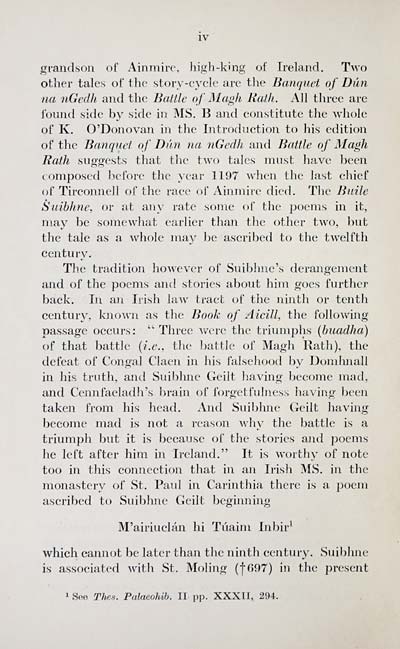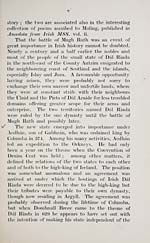Download files
Complete book:
Individual page:
Thumbnail gallery: Grid view | List view

grandson of Ainmire, high-khig of Ireland. Two
ohher tales of the story-cycle are the Banquet of Dun
na iiGcdli and the Battle of Magh Rath. All three are
ibnnd side by side in MS. B ajid constitnte the whole
of K. O'Donovan in the Introduction to his edition
of the Banquet of Dim na nGedh and Battle of Magh
Rath suggests that the two tales must have been
composed before the year 1197 when the last chief
of Tirconnell of the race of Ainmiic died. The Buile
Suibhne, or at any rate some of the poems in it,
may be somewhat earlier than the other two, but
the tale as a whole may be ascribed to the twelfth
century.
The tradition however of Suibhne's derangement
and of the poems and stories about him goes further
back. In an Irish law tract of the ninth or tenth
century, kjiown as the Book of Aicill, the following
passage occurs: " Three were the triumphs (buadha)
of that battle {i.e., the battle of Magh Rath), the
defeat of Congal Claen in his falsehood by Domhnall
in his truth, and Suibhne Geilt having become mad,
and Cennfaeladh's brain of forgetfulness having been
taken from his head. And Suibhne Geilt having
become mad is not a reason why the battle is a
triumph but it is because of the stories and poems
he left after him in Ireland." It is worthy of note
too in this connection that in an Irish MS. in the
monastery of St. Paul in Carinthia there is a poem
ascribed to Suibhne Geilt beginning
M'airiiiclán hi Túaim Inbir^
which cannot be later than the ninth centnry. Suibhne
is associated with St. Moling (fG97) in the present
1 See Thes. Palaeohih. II ))p. XXXII, 294.
ohher tales of the story-cycle are the Banquet of Dun
na iiGcdli and the Battle of Magh Rath. All three are
ibnnd side by side in MS. B ajid constitnte the whole
of K. O'Donovan in the Introduction to his edition
of the Banquet of Dim na nGedh and Battle of Magh
Rath suggests that the two tales must have been
composed before the year 1197 when the last chief
of Tirconnell of the race of Ainmiic died. The Buile
Suibhne, or at any rate some of the poems in it,
may be somewhat earlier than the other two, but
the tale as a whole may be ascribed to the twelfth
century.
The tradition however of Suibhne's derangement
and of the poems and stories about him goes further
back. In an Irish law tract of the ninth or tenth
century, kjiown as the Book of Aicill, the following
passage occurs: " Three were the triumphs (buadha)
of that battle {i.e., the battle of Magh Rath), the
defeat of Congal Claen in his falsehood by Domhnall
in his truth, and Suibhne Geilt having become mad,
and Cennfaeladh's brain of forgetfulness having been
taken from his head. And Suibhne Geilt having
become mad is not a reason why the battle is a
triumph but it is because of the stories and poems
he left after him in Ireland." It is worthy of note
too in this connection that in an Irish MS. in the
monastery of St. Paul in Carinthia there is a poem
ascribed to Suibhne Geilt beginning
M'airiiiclán hi Túaim Inbir^
which cannot be later than the ninth centnry. Suibhne
is associated with St. Moling (fG97) in the present
1 See Thes. Palaeohih. II ))p. XXXII, 294.
Set display mode to: Large image | Transcription
Images and transcriptions on this page, including medium image downloads, may be used under the Creative Commons Attribution 4.0 International Licence unless otherwise stated. ![]()
| Early Gaelic Book Collections > Matheson Collection > Buile Shuibhne > (12) |
|---|
| Permanent URL | https://digital.nls.uk/76546108 |
|---|
| Description | Irish text, English preliminaries and notes. |
|---|---|
| Shelfmark | Mat.33 |
| Additional NLS resources: | |
| Attribution and copyright: |
|
| Description | Items from a collection of 170 volumes relating to Gaelic matters. Mainly philological works in the Celtic and some non-Celtic languages. Some books extensively annotated by Angus Matheson, the first Professor of Celtic at Glasgow University. |
|---|
| Description | Selected items from five 'Special and Named Printed Collections'. Includes books in Gaelic and other Celtic languages, works about the Gaels, their languages, literature, culture and history. |
|---|

